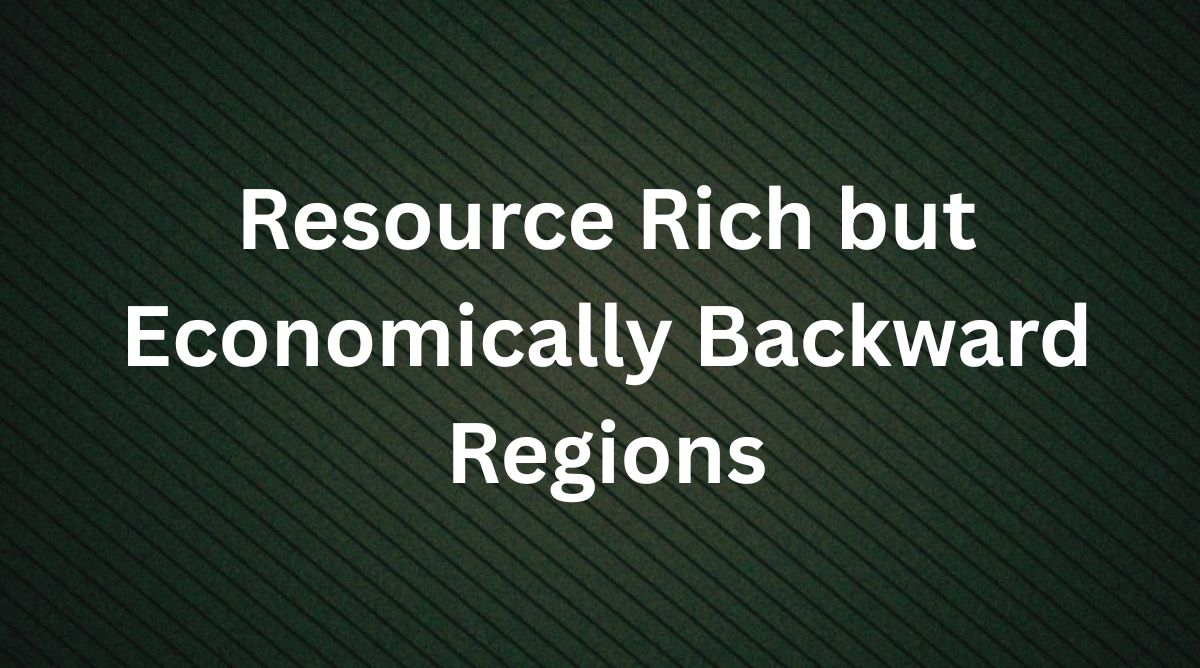
In many parts of the world, abundant natural resources coexist with persistent poverty and underdevelopment. This phenomenon, often encapsulated in the term “resource curse,” highlights the paradox where regions endowed with significant natural wealth remain economically backward. In this article, we delve into what makes a region resource rich yet economically backward, examine several illustrative examples from different parts of the globe, analyze the underlying causes of this paradox, and consider strategies that could help overcome these challenges.
Defining the Paradox
Resource Richness
A region is considered resource rich when it possesses abundant deposits of natural assets such as minerals, oil, natural gas, timber, or fertile land. These resources have the potential to generate significant revenue and drive economic growth if managed properly.
Economic Backwardness
Conversely, economic backwardness is characterized by low levels of income, inadequate infrastructure, poor educational and health facilities, and overall underdevelopment. In such regions, despite having valuable natural resources, local populations often experience high poverty rates, limited job opportunities, and substandard living conditions.
The paradox arises when these seemingly advantageous natural endowments fail to translate into widespread economic prosperity. Instead, the wealth generated by these resources may concentrate in the hands of a few, or it might even lead to instability and conflict, ultimately stunting overall development.
The Resource Curse Phenomenon
The term resource curse refers to the counterintuitive observation that countries or regions with an abundance of natural resources tend to experience less economic growth, poorer development outcomes, and higher levels of corruption than resource-poor regions. Several theories have been proposed to explain this paradox, including:
- Economic Volatility:
Resource prices are subject to global market fluctuations, leading to unstable revenues that complicate long-term planning and investment in diversified economic sectors. - Dutch Disease:
An influx of resource revenues can lead to currency appreciation, which makes other export sectors less competitive on the global market. As a result, economies become overly dependent on a single resource sector. - Corruption and Governance Issues:
The management of resource wealth can create incentives for rent-seeking, corruption, and nepotism, resulting in poor public investment and ineffective governance. - Neglect of Human Capital:
Heavy reliance on natural resources may reduce the incentive to invest in education, health, and infrastructure, thereby stifling overall human and economic development. - Conflict and Instability:
Competition for control over lucrative resources can lead to social conflict and even violent disputes, further undermining development efforts.
Examples of Resource Rich but Economically Backward Regions
Below are some notable examples from different continents that illustrate this phenomenon:
1. The Democratic Republic of the Congo (DRC)
Resource Wealth:
The DRC is famously rich in minerals such as cobalt, copper, diamonds, tantalum, and coltan. These resources are essential components in modern technologies, including smartphones, electric vehicles, and various high-tech devices.
Economic Backwardness:
Despite this mineral wealth, the DRC remains one of the poorest countries in the world. Political instability, corruption, and ongoing conflicts have hampered efforts to translate resource wealth into sustainable development. Infrastructure remains severely underdeveloped, and basic services such as healthcare and education are in a critical state.
2. Angola
Resource Wealth:
Angola is endowed with significant oil reserves and diamond deposits. The country experienced rapid economic growth in the early 2000s due to high oil prices, attracting substantial foreign investment.
Economic Backwardness:
However, this wealth has not been evenly distributed among the population. High levels of corruption, weak institutions, and a lack of diversified economic activity have resulted in widespread poverty. Many Angolans still struggle with inadequate healthcare, education, and infrastructure.
3. Chad
Resource Wealth:
Chad possesses valuable oil reserves that have the potential to transform its economy. The oil sector is a major revenue source for the country.
Economic Backwardness:
Despite its resource wealth, Chad faces challenges such as political instability, underdeveloped infrastructure, and limited human capital. The revenues from oil have not been sufficiently reinvested in public services or economic diversification, leaving large segments of the population in poverty.
4. Papua New Guinea
Resource Wealth:
Papua New Guinea is rich in natural resources, including gold, copper, oil, and natural gas. Its vast natural wealth positions it as a key player in the global resource market.
Economic Backwardness:
The country, however, is hampered by poor infrastructure, geographical isolation, and governance challenges. Despite high potential revenues from resource extraction, many areas remain underdeveloped, and the benefits of resource wealth have not translated into broad-based economic growth or improved living standards for the majority of its citizens.
5. The Niger Delta Region, Nigeria
Resource Wealth:
The Niger Delta is one of the world’s most oil-rich regions. Nigeria’s oil exports constitute a significant portion of the country’s revenue and have the potential to drive substantial economic development.
Economic Backwardness:
Despite this, the Niger Delta remains economically backward. The region suffers from environmental degradation, frequent oil spills, and conflicts over resource control. The wealth generated by oil has often been mismanaged, leading to significant socioeconomic disparities and persistent poverty among local communities.
6. Certain Mineral-Rich States in India
Resource Wealth:
Regions like Jharkhand and Chhattisgarh in India are rich in minerals such as coal, iron ore, bauxite, and various other ores. These states contribute significantly to India’s mining sector.
Economic Backwardness:
Despite the resource wealth, these regions have not seen commensurate economic development. Issues such as inadequate infrastructure, environmental degradation, and a lack of investment in human capital have left many communities impoverished. Local populations often do not benefit proportionately from the mining activities, and the wealth generated tends to be concentrated among large corporations and political elites.
7. Some Regions in Latin America
Resource Wealth:
Several regions in Latin America, such as parts of Bolivia and Venezuela, are rich in natural resources like lithium, natural gas, and oil. These resources hold enormous potential for economic development.
Economic Backwardness:
However, mismanagement, political instability, and economic policies that fail to invest adequately in social infrastructure have left these regions lagging behind in overall development. In some cases, resource wealth has led to significant social and economic inequalities rather than broad-based prosperity.
Factors Contributing to the Paradox
Understanding why these resource-rich regions remain economically backward requires examining several critical factors:
1. Poor Governance and Corruption
Effective governance is crucial for ensuring that resource revenues are managed transparently and invested in the public good. In many of these regions, weak governance and endemic corruption divert wealth away from essential services and infrastructure projects. This results in a cycle where resource wealth fails to generate sustainable economic growth.
2. Lack of Economic Diversification
An overreliance on a single resource or sector often stifles broader economic development. When economies become too dependent on natural resources, they tend to neglect other sectors such as manufacturing, agriculture, and services. This lack of diversification makes them vulnerable to price fluctuations and global market instability.
3. Inadequate Infrastructure
Infrastructure is the backbone of economic development. In many resource-rich regions, inadequate transportation, energy, and communication infrastructure impede the effective utilization of resource wealth. Poor roads, unreliable power supply, and limited access to technology prevent local economies from fully integrating with global markets.
4. Social and Political Instability
Resource wealth can sometimes fuel conflict and political instability. Competing interests over resource control often lead to social unrest, civil conflict, or even war. This instability discourages investment, disrupts economic activity, and further entrenches poverty.
5. Environmental Degradation
The extraction and exploitation of natural resources can have severe environmental consequences. Pollution, deforestation, and the degradation of land and water resources can undermine the livelihoods of local populations, reducing agricultural productivity and overall quality of life. Environmental damage also incurs significant costs in terms of public health and rehabilitation.
6. Inadequate Investment in Human Capital
While resource extraction can generate substantial revenues, these funds are not always reinvested in education, healthcare, and skill development. Without a well-educated and healthy workforce, regions struggle to build diversified economies that can drive long-term development. Investments in human capital are essential to break the cycle of poverty and to harness resource wealth for sustainable growth.
Strategies for Breaking the Cycle
To overcome the challenges of the resource curse, several strategies can be employed:
1. Strengthening Governance and Institutions
Improving the transparency and accountability of government institutions is critical. Implementing robust anti-corruption measures, enforcing the rule of law, and ensuring that resource revenues are allocated effectively can help create a more stable economic environment.
2. Economic Diversification
Investing in sectors beyond natural resource extraction is key to building a resilient economy. Governments and private investors need to focus on developing manufacturing, agriculture, tourism, and service industries. Diversification reduces dependency on volatile resource markets and provides more stable sources of income and employment.
3. Infrastructure Development
Significant investments in infrastructure can facilitate economic growth by improving access to markets, reducing production costs, and enhancing the overall quality of life. Governments should prioritize projects that develop transportation networks, energy supply, and communication systems to support broader economic activities.
4. Environmental Sustainability
Implementing sustainable resource management practices is essential to mitigate environmental damage. Investing in technologies and methods that reduce pollution and restore degraded ecosystems can help ensure that resource extraction does not compromise long-term economic prospects or public health.
5. Investment in Human Capital
Allocating a portion of resource revenues to education, healthcare, and vocational training can empower local populations and foster a more dynamic and innovative economy. A well-educated and skilled workforce is better equipped to drive diversification and to manage the challenges of a globalized economy.
6. Encouraging Foreign and Domestic Investment
Creating a favorable business environment that attracts both foreign and domestic investors can stimulate economic diversification. Clear policies, reduced bureaucratic hurdles, and incentives for investment in non-resource sectors can help channel resource wealth into broader economic development.
Conclusion
Resource-rich regions that remain economically backward represent a complex and multifaceted challenge. Countries and regions like the Democratic Republic of the Congo, Angola, Chad, Papua New Guinea, parts of the Niger Delta, mineral-rich states in India, and certain areas in Latin America illustrate how abundant natural resources can coexist with persistent poverty and underdevelopment. The resource curse phenomenon is driven by factors such as poor governance, lack of economic diversification, inadequate infrastructure, social and political instability, environmental degradation, and insufficient investment in human capital.
Breaking the cycle requires a comprehensive approach that strengthens governance, promotes economic diversification, and invests in infrastructure and human capital while ensuring environmental sustainability. Although resource wealth has the potential to transform economies, realizing that potential depends on the effective management of resources and the equitable distribution of wealth.
By addressing these challenges head-on, resource-rich regions can begin to harness their natural wealth to drive sustainable development, improve living standards, and create more resilient and diversified economies. The journey from resource curse to resource blessing is arduous, but with concerted efforts from governments, international partners, and local communities, it is a transformation that can be achieved over time.
Disclaimer: This article is for informational and educational purposes only. It does not constitute professional economic, legal, or policy advice. Readers are encouraged to consult relevant experts and conduct further research when exploring the issues discussed herein.
Also Check:
• How Overfishing and the Decimation of Forests Prove Harmful: A Comprehensive Analysis
• How Can We Conserve Resources? A Guide for Class 8
• How Can Water Neutrality Be Achieved? A TCS Perspective
• When Goodwill Is Not Purchased, the Goodwill Account Cannot Be Recognized: An In-Depth Exploration




2 thoughts on “Resource Rich but Economically Backward Regions: An In-Depth Exploration”